Starbucks Bundle
How Does Starbucks Brew Success?
Starbucks, a global coffeehouse titan, isn't just about your morning latte; it's a complex operation with a massive global footprint. From its humble beginnings in Seattle, the company has transformed the coffee industry and redefined the 'third place' experience for millions. Understanding Starbucks SWOT Analysis is key to grasping its core.
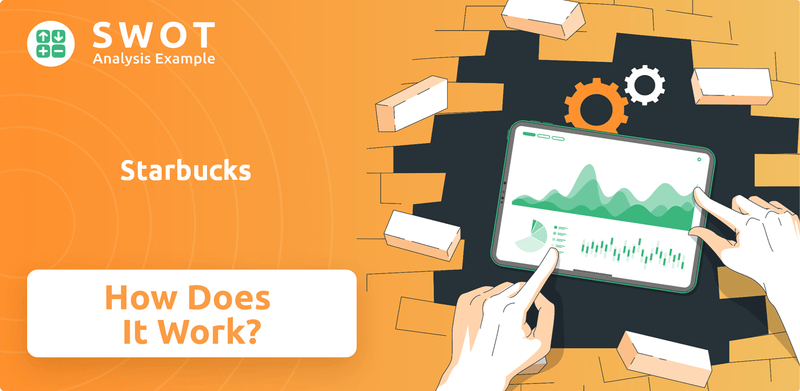
This exploration into How Starbucks works will dissect the company's intricate Starbucks business model, revealing how it generates revenue and maintains its competitive edge. We'll examine Starbucks operations, its strategic moves, and its ability to navigate the ever-changing market landscape. Whether you're an investor, a customer, or simply curious, this analysis provides a comprehensive look at the inner workings of a global icon.
What Are the Key Operations Driving Starbucks’s Success?
The core of the Starbucks business model revolves around delivering a premium coffeehouse experience. It provides a diverse array of products, including coffee, espresso, tea, and other handcrafted beverages, along with food items like pastries and sandwiches. This approach caters to a wide customer base, from those seeking a quick caffeine fix to individuals looking for a comfortable space to socialize or work. The company's success is built on a blend of product quality, atmosphere, and customer service, creating a 'third place' experience distinct from home or work.
The value proposition of Starbucks centers on offering high-quality products within a welcoming environment. The company strategically positions itself as more than just a coffee shop; it's a destination. This is achieved through consistent product quality, a focus on customer service, and the creation of a comfortable atmosphere. This strategy allows Starbucks to command a premium price point, enhancing profitability and brand loyalty.
The company's operational processes are carefully managed to ensure consistency and quality across its global footprint. From sourcing coffee beans to store design, every aspect of the Starbucks experience is meticulously planned and executed. This attention to detail is a key factor in maintaining its brand reputation and customer loyalty, which is crucial for its financial performance and competitive advantage, as highlighted in the Competitors Landscape of Starbucks.
The company sources coffee beans from over 30 countries worldwide. These beans are then roasted in seven global processing plants to maintain a consistent flavor profile. This meticulous sourcing and roasting process is critical to the quality of its products and maintaining its brand identity.
Starbucks adapts its offerings and marketing to suit local preferences through a multi-domestic strategy. This includes tailoring menus with region-specific items, like matcha-infused desserts in Japan. The company balances global brand consistency with local relevance to appeal to diverse markets.
The supply chain emphasizes direct control to ensure quality, with distribution networks leveraging both company-operated stores and licensed partnerships. As of Q2 Fiscal Year 2025, 53% of its 40,789 stores were company-operated, and 47% were licensed. This approach allows for expansion while maintaining brand standards.
The company has a robust digital presence, particularly through its mobile app and loyalty program. This digital integration allows for mobile ordering and payment, personalized recommendations, and customer behavior insights. This enhances convenience and fosters customer loyalty.
The company's operations are unique due to its focus on the 'third place' experience, its commitment to sustainability, and its robust digital presence. Its investment in employee training and benefits also contributes to lower turnover and consistent service quality, differentiating it from competitors. These elements contribute to Starbucks' competitive advantages.
- The 'third place' experience focuses on creating a welcoming environment for customers.
- Commitment to sustainability involves ethical sourcing and environmental initiatives.
- Digital presence enhances convenience and customer engagement.
- Employee training and benefits contribute to consistent service quality and lower turnover.
Starbucks SWOT Analysis
- Complete SWOT Breakdown
- Fully Customizable
- Editable in Excel & Word
- Professional Formatting
- Investor-Ready Format
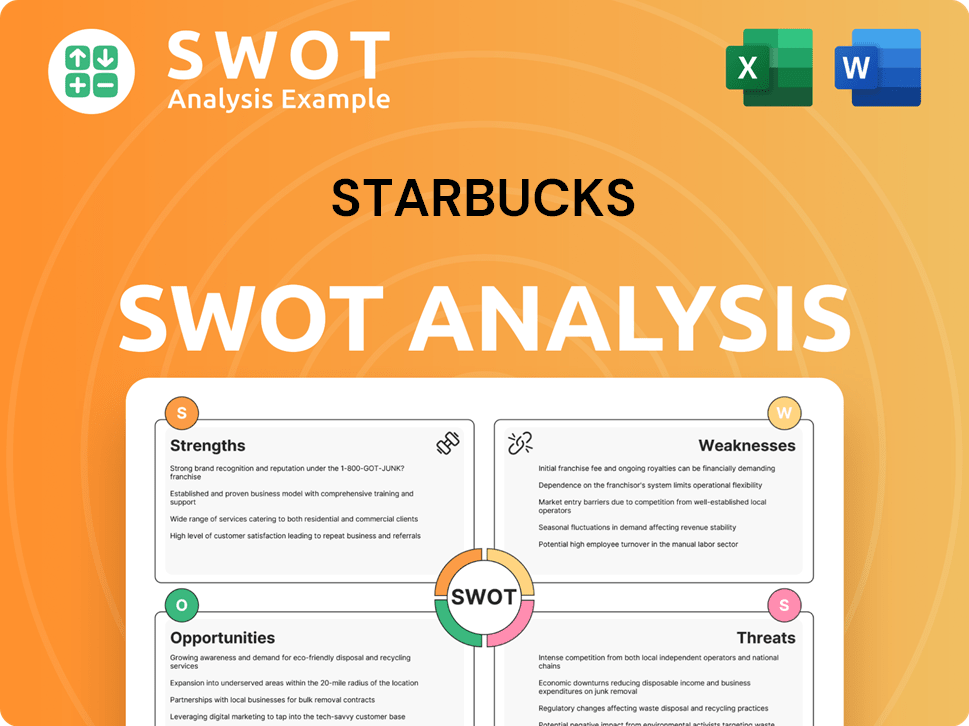
How Does Starbucks Make Money?
Understanding how the Starbucks business model generates revenue reveals a multifaceted approach. The company leverages a combination of direct sales, licensing, and strategic partnerships to maximize its financial performance. This diversified strategy allows Starbucks to maintain a strong presence in the global market.
The core of Starbucks operations centers around its retail stores, which are the primary source of revenue. These stores generate income through the sale of coffee, food, and other merchandise. Additionally, the company expands its reach through licensed stores, which contribute to overall revenue and brand visibility.
The Starbucks strategy also includes revenue from the Channel Development segment, which involves selling packaged products. This segment includes packaged coffees, teas, and ready-to-drink beverages sold in grocery stores and other channels. This diversification helps Starbucks reach a broader consumer base and increase its revenue streams.
The majority of revenue comes from sales in company-operated stores. In Q2 Fiscal Year 2025, consolidated net revenues increased by 2% to $8.8 billion. This includes sales of beverages, food, and merchandise.
Licensed stores generate revenue through royalty fees and product sales. These stores expand the brand's global footprint. This model allows for broader market penetration with lower capital investment.
This segment includes packaged coffee, tea, and ready-to-drink beverages sold in various retail channels. In Q2 FY25, net revenues for this segment were $409.0 million. This diversifies the revenue streams.
The loyalty program incentivizes repeat business. It drives customer engagement through exclusive deals and personalized recommendations. This enhances customer retention and increases sales.
The mobile app facilitates ordering, payment, and user behavior tracking. It is a key driver of customer engagement. It provides convenience and personalized experiences.
The partnership with Nestlé expands the distribution of Starbucks products. This alliance generated $2.1 billion in revenue in 2024. It generates licensing fees and wholesale income.
The Starbucks strategy includes several innovative monetization strategies to enhance customer engagement and drive sales. The Starbucks Rewards loyalty program and the mobile app are crucial in this regard. Furthermore, strategic partnerships, such as the Global Coffee Alliance with Nestlé, have significantly expanded the distribution of Starbucks products. For more details on the company's financial performance, you can explore Owners & Shareholders of Starbucks.
The company uses various strategies to maximize revenue and customer engagement.
- Starbucks Rewards: The loyalty program provides exclusive deals and personalized recommendations, encouraging repeat business.
- Mobile App: The app facilitates mobile ordering, payment, and personalized experiences.
- B2B Partnerships: The Global Coffee Alliance with Nestlé expands product distribution and generates licensing fees.
- AI Personalization: AI-powered features in the mobile app offer personalized suggestions based on user behavior.
Starbucks PESTLE Analysis
- Covers All 6 PESTLE Categories
- No Research Needed – Save Hours of Work
- Built by Experts, Trusted by Consultants
- Instant Download, Ready to Use
- 100% Editable, Fully Customizable
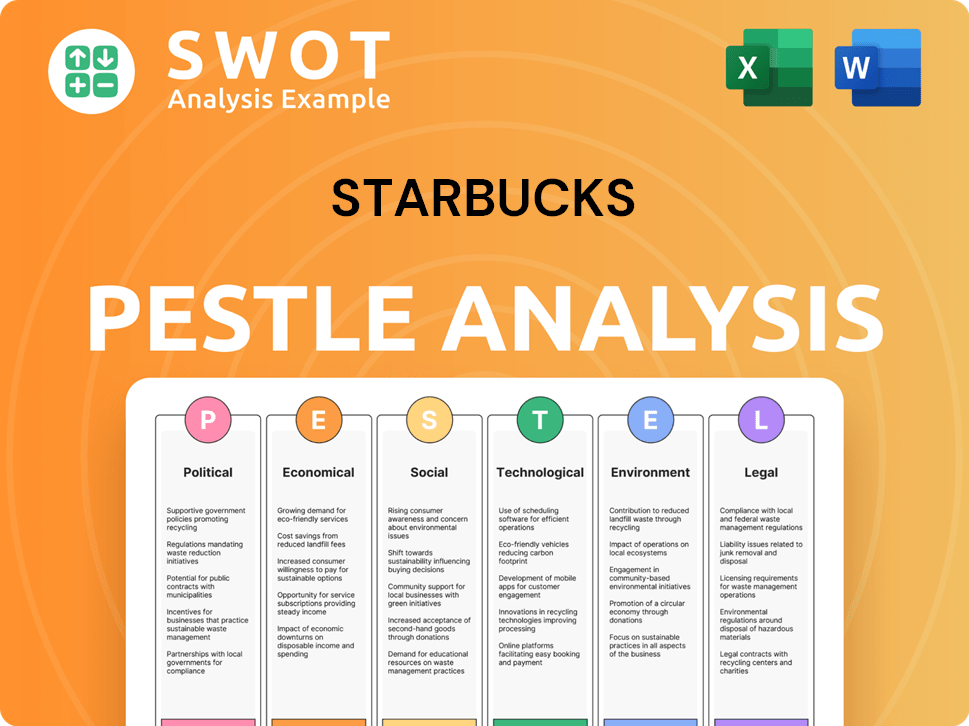
Which Strategic Decisions Have Shaped Starbucks’s Business Model?
Navigating significant milestones and strategic maneuvers, the journey of the company has been marked by pivotal shifts. A notable move in 2024 was the introduction of the 'Back to Starbucks' strategy, aimed at revitalizing the in-store customer experience and enhancing operational efficiency. This initiative, led by CEO Brian Niccol, focuses on improving the 'third place' environment, elevating coffee quality, and strengthening customer connections.
The company has faced challenges, including global supply chain disruptions and intense competition, particularly in international markets. In Q2 FY25, global comparable store sales declined by 1%, influenced by a 2% decrease in comparable transactions. In China, comparable store sales fell 11% in May 2024. In response, the company is streamlining its menu and making workforce adjustments to create more agile teams.
The company's competitive advantages are rooted in its strong brand recognition, innovative business model, and technological leadership. Its global presence, with over 40,000 stores, provides economies of scale and diverse revenue streams. The company's commitment to sustainability also enhances its brand image and attracts environmentally conscious consumers. For more insights into the company's growth, consider exploring the Growth Strategy of Starbucks.
The 'Back to Starbucks' strategy includes several key initiatives. These involve reintroducing self-serve condiment bars and offering free refills to customers using reusable cups. Optimizing store layouts for better flow, including dedicated pick-up shelves for mobile orders, is also a priority.
To improve service speed and efficiency, the company plans to simplify its menu by 30% by the end of fiscal year 2025. Strategic workforce adjustments, including laying off 1,100 corporate employees in February 2025, aim to create more agile teams.
The company faces intense competition, particularly in international markets like China. Rivals such as Luckin Coffee and Cotti Coffee are gaining market share. The company is responding to these challenges by adapting its strategies and focusing on key areas for improvement.
The company continues to adapt by focusing on digital and delivery services. It is also diversifying its product offerings beyond coffee and investing in health and wellness trends. The mobile app and loyalty programs provide a significant edge.
The company's competitive advantages include strong brand recognition, which allows it to command premium prices and foster customer loyalty. Its innovative business model and technological leadership provide a significant edge. The global presence, with over 40,000 stores, offers economies of scale and diverse revenue streams.
- Strong brand recognition and customer loyalty.
- Innovative business model, including new product introductions.
- Technology leadership through mobile app and loyalty programs.
- Global presence with over 40,000 stores worldwide.
Starbucks Business Model Canvas
- Complete 9-Block Business Model Canvas
- Effortlessly Communicate Your Business Strategy
- Investor-Ready BMC Format
- 100% Editable and Customizable
- Clear and Structured Layout
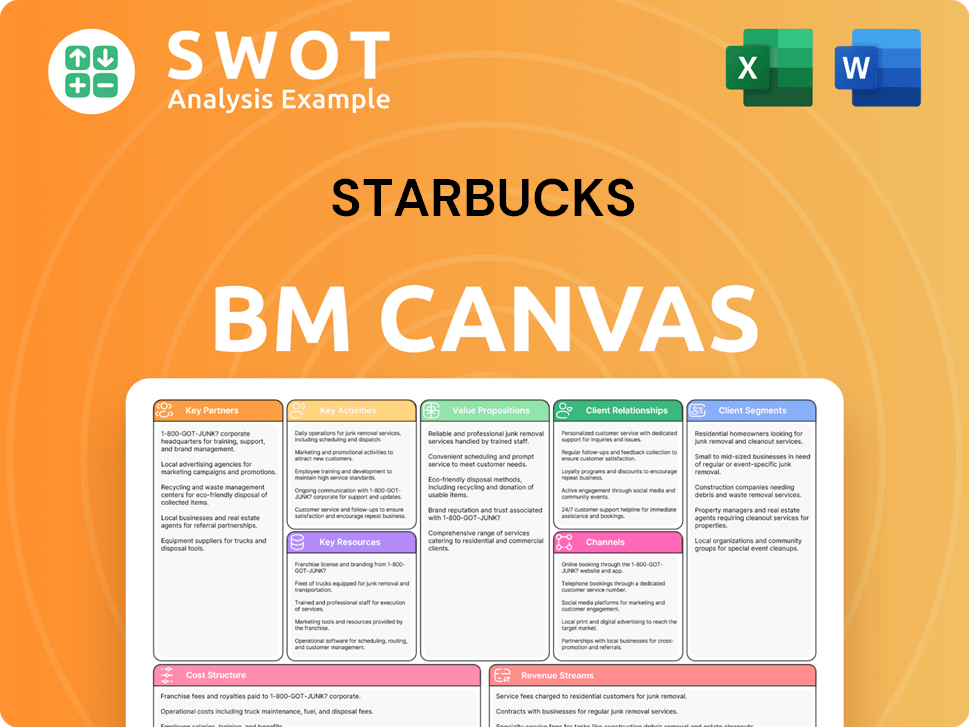
How Is Starbucks Positioning Itself for Continued Success?
The global coffee industry is dominated by Starbucks, a company known for its premium quality and extensive global presence. As of Q2 Fiscal Year 2025, the company operated 40,789 stores worldwide. Despite a strong brand and a loyal customer base, the company faces increasing competition from specialty coffee shops and large chains.
Key risks include weakening consumer demand, rising labor costs, and fluctuations in commodity prices. Moody's Ratings changed the outlook to negative in April 2025 due to weakening profitability. Declines in comparable store sales, including a 1% global decline in Q2 FY25, signal ongoing challenges. To learn more about the company's beginnings, you can read a Brief History of Starbucks.
Starbucks maintains a leading position in the global coffee market, with a presence in over 80 countries. However, its market share in China dropped from 34% in 2019 to 14% in 2024 due to aggressive local competitors. This shift highlights the competitive pressures the company faces in various markets.
The company faces risks such as weakening consumer demand, particularly in the U.S., and rising labor costs. Fluctuations in coffee bean prices and global supply chain disruptions also impact profitability. These factors contribute to the challenges the company navigates.
Starbucks is focusing on strategic initiatives to improve the in-store experience, enhance digital capabilities, and drive operational efficiencies. The company plans to add new coffee brewers and accelerate kitchen redesigns. Expansion into emerging markets is also a key focus.
The company projects revenue to grow at a CAGR of +7.87% and EPS to increase at a CAGR of +21.48% over the next few years. The company anticipates a recovery in operating margins by fiscal year 2028, aiming for long-term, durable growth.
Starbucks is implementing its 'Back to Starbucks' strategy to improve the in-store experience and enhance digital capabilities. The company is also expanding into emerging markets, with plans to open 500 new outlets in the Middle East over the next five years and targeting 9,000 stores in China by 2025.
- Focus on in-store experience improvements.
- Enhancement of digital capabilities.
- Expansion into new markets, particularly in the Middle East and China.
- Operational efficiency through kitchen redesigns and new equipment.
Starbucks Porter's Five Forces Analysis
- Covers All 5 Competitive Forces in Detail
- Structured for Consultants, Students, and Founders
- 100% Editable in Microsoft Word & Excel
- Instant Digital Download – Use Immediately
- Compatible with Mac & PC – Fully Unlocked
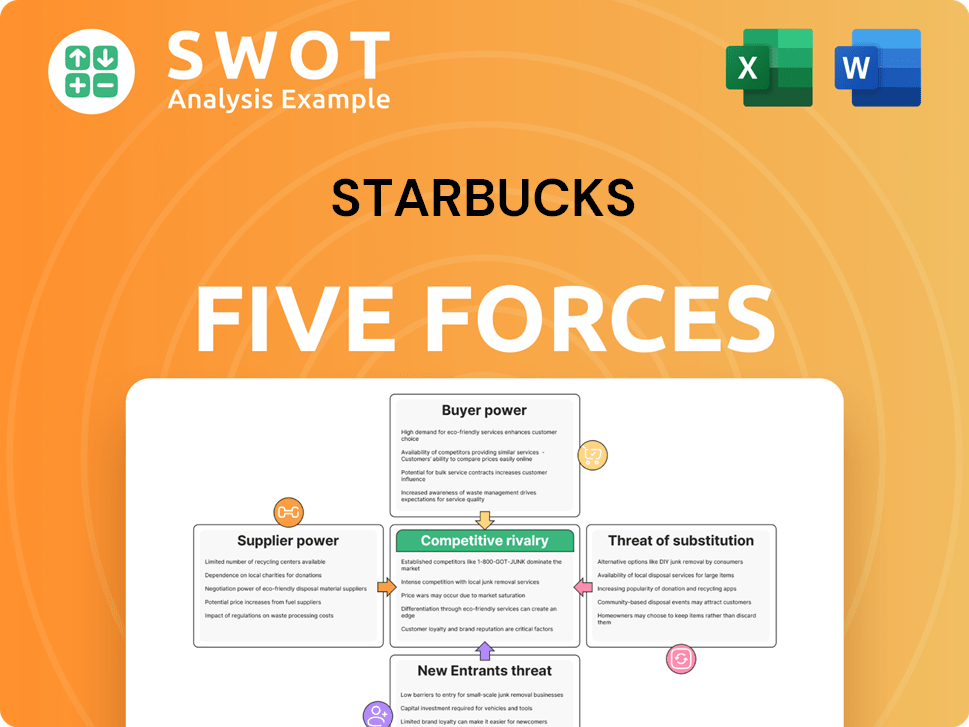
Related Blogs
- What are Mission Vision & Core Values of Starbucks Company?
- What is Competitive Landscape of Starbucks Company?
- What is Growth Strategy and Future Prospects of Starbucks Company?
- What is Sales and Marketing Strategy of Starbucks Company?
- What is Brief History of Starbucks Company?
- Who Owns Starbucks Company?
- What is Customer Demographics and Target Market of Starbucks Company?
Disclaimer
All information, articles, and product details provided on this website are for general informational and educational purposes only. We do not claim any ownership over, nor do we intend to infringe upon, any trademarks, copyrights, logos, brand names, or other intellectual property mentioned or depicted on this site. Such intellectual property remains the property of its respective owners, and any references here are made solely for identification or informational purposes, without implying any affiliation, endorsement, or partnership.
We make no representations or warranties, express or implied, regarding the accuracy, completeness, or suitability of any content or products presented. Nothing on this website should be construed as legal, tax, investment, financial, medical, or other professional advice. In addition, no part of this site—including articles or product references—constitutes a solicitation, recommendation, endorsement, advertisement, or offer to buy or sell any securities, franchises, or other financial instruments, particularly in jurisdictions where such activity would be unlawful.
All content is of a general nature and may not address the specific circumstances of any individual or entity. It is not a substitute for professional advice or services. Any actions you take based on the information provided here are strictly at your own risk. You accept full responsibility for any decisions or outcomes arising from your use of this website and agree to release us from any liability in connection with your use of, or reliance upon, the content or products found herein.